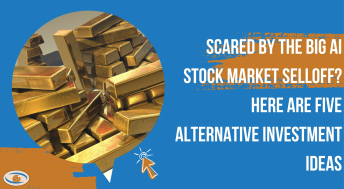Economic history shows that bubbles follow recurring patterns and exhibit identifiable warning signs
Every day at 5i Research, we see some version of a current concern about the markets. An “expert” in the media says something, or we get a question from a customer, along the lines of: “The stock market has gone up too much, we must be in a bubble.” First, just because something is good does not mean it is about to turn bad. Fortunes are made in the market by not selling a winner too early and staying invested despite all the doom-sayers telling you to get out. But to address the “bubble” concern, let’s look at what defines a bubble and take a look at how the current situation does, or does not, match past market bubble tops.
A stock market or asset bubble is characterized by prices rising far beyond their fundamental value, driven more by emotion and speculation than by earnings or productivity. Economic history shows that bubbles follow recurring patterns and exhibit identifiable warning signs across valuation, sentiment, leverage, and liquidity cycles.
Here are key signs of a bubble.
Extreme overvaluation
Bubbles can occur when market valuations far exceed historical norms relative to fundamentals such as earnings or book value. Common metrics include the price-to-earnings (P/E) ratio or the cyclically adjusted P/E (CAPE) ratio; when these remain well above long-run averages, it often signals excessive optimism. Many pundits think the market is overvalued right now, but we don’t think it is, at least to the same degree as many think. Earnings are rising and interest rates are falling. This should allow for higher valuations. The S&P 500 is at a forward price-to-earnings of 23 times right now. Certainly not low on first blush (it was as low as five times in the early 1900s), but if we look at data past 1990 the average has been 24 to 25 times. Most would say it is “fairly priced” not “bubble priced.” The index price/earnings multiple has been as high as 130 (in the dark days of the financial crisis, when companies were hardly making any money, if at all).
Leverage and credit expansion
Leverage is often blamed for the 1987 stock market crash, about 38 years ago. Rising use of borrowed money, such as margin debt in equities or high loan-to-value ratios in real estate, amplifies gains during bull phases and magnifies losses afterward. Easy credit or relaxed lending standards frequently accompany bubbles. Currently, there is a lot of concern about margin debt. According to the U.S. Financial Industry Regulatory Authority (FINRA), margin debt is at about US$1.1 trillion. Sure, it is a big number, and is at a record. It represents two per cent of total S&P 500 market value, and is up 35 per cent in the past year. But again, it may not be as bad as it sounds. The S&P 500 is up about 15 per cent in the past year so some margin expansion is expected. Lower interest rates also help investors manage their debt exposure. And, two per cent of the S&P 500 does not sound like a lot, considering expected earnings growth forecasts in the 10 per cent or more range for next year. Still, margin debt is certainly something to watch, and may be a sign of future troubles.
Euphoria, speculative behavior and media hype
Bubbles often occur where confidence turns into collective euphoria where “this time is different” becomes the narrative. Investors begin buying simply because prices are rising rather than for earnings or yield reasons. Media coverage, social pressure, and FOMO (fear of missing out) dominate sentiment. Bubbles thrive on compelling stories: new technologies, structural shifts or policy “floors” that supposedly justify inflated valuations. When media attention expands faster than fundamentals, it often creates self-reinforcing demand. A perfect example this week was Beyond Meat Inc., which rose nearly 400 per cent in the first three days of the week on some relatively minor news. Beyond was once worth US$11 billion before nearly collapsing to about 50 cents just last week. It never declared bankruptcy but it did have to exchange debt for shares. None of this mattered to investors this week, though. Bubble watch? Certainly, some areas of the market, such as quantum computing and others, are acting like some bubbles.
Surge in IPOs and risky M&A
Bubbles are often characterized by a flood of new stock issues or high-premium acquisitions that often mark market tops. Management teams, like retail investors, become overconfident and assume boom conditions will persist indefinitely. Executives go shopping for other companies, often using leverage to make deals. They care less about valuations and more about growth and empire building. Where do we stand on this today? Well, there have been some recent IPOs, and merger and acquisition activity has heated up. But we are nowhere near a flood of deals, and one can also argue that the increased activity relates to solid business confidence and lower rates ahead rather than anything to worry about. This signal doesn’t seem to be flashing bubble to us.
Excess liquidity
Bubbles often occur when central banks or investors supplying abundant cheap credit — through low interest rates or stimulus — often inflate asset prices beyond rational levels. This monetary excess can mask underlying fragility. Some of this was displayed in 2020 when governments worldwide flooded the market with credit to try and stem the COVID-19 pandemic-induced economic declines. Interest rates effectively went to zero and many stocks soared well beyond fundamental valuations. Companies such as Peloton Interactive Inc., worth US$50 billion in 2021 and only worth about US$3 billion today. How does today look? Well, the U.S. and Canada ratcheted up interest rates in 2022 and have only just started to relax credit. The U.S. has only had one interest rate cut so far in the current cycle. We are hardly at the “free money” stage of the economy, and this indicator does not at all seem to be in bubble range.
Unlock the Power of Informed Investing with 5i Research!
DIY investing doesn't have to mean going it alone. At 5i Research, we're your trusted partner in navigating the stock market. Our platform offers comprehensive stock and market research, empowering you to make smart investment decisions.
- Investor Q&A: Have burning questions? Get answers from our team of experts and fellow investors in our dedicated Q&A section.
- Research Reports: With over 60 meticulously researched Canadian stocks, our reports offer in-depth analysis, giving you the confidence to invest wisely.
- Model Portfolios, Alerts, Forums, Portfolio Tracking, and Much More.
Take Care,







Comments
Login to post a comment.